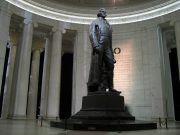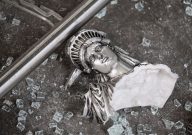What’s in a Name?
The urge to apply names to persons, places and things is one of the oldest of human impulses, dating back to the Garden of Eden, and certainly as old as Alexander the Great’s decision to apply his own name to the city he founded—or almost founded—in the Nile River delta in 331 BC. Americans also took to the naming process, and very early. The Massachusetts Bay colony named its college in 1636 for its benefactor, John Harvard; the Connecticut colony’s college was likewise named for Elihu Yale; New Hampshire’s Dartmouth College was named for the Earl of Dartmouth, and Virginia’s for King William and Queen Mary. Towns in Pennsylvania were named for politicians the colonists especially admired, such as John Wilkes and Isaac Barré (hence the modern city of Wilkes-Barre); my own hometown was named Paoli in honor of the Corsican freedom fighter of the 1750s, Pasquale di Paoli, who is immortalized in James Boswell’s life of Samuel Johnson. Even the first permanent European settlement adopted for itself the name of King James I; hence, Jamestown.
The Jamestown colonists did not, significantly, consult with the local Powhatan tribes all around them in this naming process (if there really was a process at all) or ask whether this dour son of Mary, Queen of Scots, was eminently worthy of such honor—and thereby sowed the seed of controversies we are now reaping over affixing names to institutions.
Because not all namings are connected to individuals of permanent admiration. The American Revolution forced the re-naming of King’s College in New York City as Columbia. The massive fortification built at the tip of the James River peninsula was named Fortress Monroe in honor of the fifth president; a smaller fortification in mid-stream was named Fort Calhoun, but with the outbreak of the Civil War, Calhoun’s name was too radioactive for Union tastes, and it was renamed Ft. Wool, for Union General John Wool. Even in the First World War, there was an effort to re-name sauerkraut as “Liberty Cabbage,” and a hamburger as a “Liberty Steak.” (The same thing was attempted more recently during the Iraq War, when France declined to participate in the “coalition of the willing,” and some agitators called for the renaming of French-fries as “Freedom Fries”).
None of the energies bestowed on these namings and re-namings has, however, quite matched the concern over the last year-and-a-half with several generations-worth of institutional namings, and almost always on the grounds of some form of cultural insensitivity or political offense. Sometimes the re-namings have been an exercise in simple good sense. John Calhoun’s name was attached to a Yale residential college in 1931 with little regard for how Calhoun provided the inspiration for the Southern secession that caused the Civil War, or for Calhoun’s undisguised white supremacist views on race and slavery, but solely because Calhoun was a famous alumnus of Yale. The name was changed in 2017 to honor Grace Murray Hopper, a pioneering computer scientist, instead, and Yale is the better for it.
But other re-naming campaigns have bordered on the risible. No one would seem to stand higher above a campaign for re-naming than Abraham Lincoln, the “Great Emancipator” and “Savior of the Union.” And yet Lincoln, too, has been the target of re-naming initiatives, and much less well-thought-out, too. The San Francisco Unified School District moved, earlier this year, to rename 44 of the schools in the district, including the one named for Abraham Lincoln, and did so because “the majority of [Lincoln’s] policies proved detrimental to Native peoples,” both in terms of encouraging settler development of the American West, and more specifically in his approval of the execution of 37 Santee Sioux after the Minnesota Sioux uprising of 1862. Not even Lincoln’s Emancipation Proclamation escaped censure. As the chair of the District’s renaming committee announced, “Lincoln, like the presidents before him and most after, did not show through policy or rhetoric that black lives ever mattered to them outside of human capital and as casualties of wealth building.”
While this campaign at least partially failed, this is an astonishing conclusion, and so baseless that it calls into question, not Lincoln, but the re-namers. No one less than Frederick Douglass, the famed black abolitionist, declared in 1865 that Lincoln was “emphatically the black man’s president,” and Douglass described Lincoln as the first important white political figure he had ever met who did not “remind me of the difference in color.” And no wonder: it is the name of Abraham Lincoln which appears at the bottom of the Emancipation Proclamation of January 1, 1863, and on the 13th Amendment, abolishing slavery in the U.S….it is Lincoln who authorized the recruitment of black soldiers for the union Army and sent them into battle to kill and conquer a white supremacist regime…it is Lincoln who was murdered by John Wilkes Booth because Booth was convinced that Lincoln was going to propose equal citizenship for the freed slaves. At length, the District board buckled to a wave of national derision and an alumni lawsuit, and rescinded the re-naming campaign in early April.
And yet other re-naming campaigns run merrily along the same track. At the University of Wisconsin at Madison, the Black Student Union and the Student Inclusion Coalition have agitated for the removal of a Lincoln statue there because “it’s a single-handed symbol of white supremacy.” Or, as one student added, “Everyone thinks of Lincoln as the great, you know, freer of slaves, but let’s be real: He owned slaves, and…we want people to know that he ordered the execution of native men.” That Lincoln never owned slaves is an easily ascertainable fact. Lincoln never lived in a slave state after leaving Kentucky at the age of seven, made his first public statement on slavery at age 28 as an Illinois state legislator by denouncing slavery as “founded on both injustice and bad policy,” and in 1864 reminded a state governor that “I am naturally anti-slavery. If slavery is not wrong, nothing is wrong. I can not remember when I did not so think, and feel.” As for ordering “the execution of native men,” Lincoln indeed authorized the execution of the 37 Santee Sioux who were hanged on December 26, 1862, at Mankato, Minnesota. But this followed a Sioux uprising in Minnesota in the summer and fall of 1862 and, after the uprising’s suppression, trials which condemned 303 Sioux to the gallows. Lincoln intervened, ordering “a careful examination of the records of the trials” and issuing pardons to all but 35 who were guilty of outright murder and two convicted of rape. “The rascality” on the part of government agents which had triggered the uprising was felt by Lincoln “down to my boots.” When he was warned that his pardons would cost him votes in Minnesota, he replied, “I could not afford to hang men for votes.”
We can deplore the rage for cancellation that has possessed the spirits of the woke without having to insist that no cancellations are legitimate.
As the example of Calhoun College demonstrates, not all re-namings are ill-informed impulses, as some commentators have complained; the case of Calhoun College is, to the contrary, a laudable act of careful and conscious re-thinking. So, what should we take as our guides in walking a deliberate and thoughtful path between turning blind eyes to historical injustices, and simply yielding to spasms of iconoclasm? Let me propose a decision-tree, which I developed with my former student, John M. Rudy, and which we have elsewhere offered as a help to understanding what to do about statues and monuments.
1. Does the naming commemorate an individual who inflicted harms on a now-living person that would be actionable in a federal court? If so, remove the name; if not, move to the next question.
2. Did that individual direct the commission of treason, capital crimes, slavery, genocide, or terrorism (as defined by the International Court of Justice) on his personal authority? If so, remove the name; if not, next question.
3. Did the individual undertake specific acts that mitigated, or led to the mitigation, of the historical harms done? But only, after this question, with this caveat: Itemize those mitigations on a plaque or other public installation, and do it clearly.
4. Did the individual have a specific connection to the institution or a legacy (or brand) integral to the institution for which it is named? If not, remove the name. If so, think hard about whether it merits a naming, then go to the next question.
5. Does use of the name mandate or induce the institution to serve as an active venue for promoting treason, capital crimes, slavery, genocide, or terrorism? If there is a demonstrable pattern of such action, consider changing the name; if not, let the naming stay but with suitable explanation highlighting why such actions do not have the sanction of the named institution, or should not be associated with the individual for whom it is named.
The truth is in the details, and the details are going to be messy. For instance, being a slaveholder would not necessarily be grounds for a “naming cancellation” but rather actively promoting enslavement. George Washington and John Marshall owned slaves, but did not order enslavement (although Washington did pursue recaption), did not propagandize for slavery, nor proclaim that slavery was a positive good for which one race was uniquely suited. Roger Taney, on the other hand, actually emancipated the slaves he originally owned, but actively promoted enslavement; John Calhoun proclaimed that it was a positive good. Edward Coles, who was originally a slaveholder (and Thomas Jefferson’s secretary), renounced slave-owning and emancipated his slaves when he moved, with them, to the Illinois Territory; hence, there should be no call for re-naming Coles County, Illinois.
We can deplore the rage for cancellation that has possessed the spirits of the woke without having to insist that no cancellations are legitimate. The Hungarians who toppled the state of Stalin in Budapest, the Iraqis who pulled down the statue of Saddam Hussein in Baghdad, and even the New Yorkers who destroyed the statue of George III on Bowling Green in lower Manhattan in 1776 were not wrong. Our account would limit those sorts of cancellations to those who had inflicted harms on now-living persons.
We stand on the shoulders of great Americans, but also on the bones of forgotten ones, and of all races and nationalities. This guide will not automatically solve all questions or end all debates, but it will allow us to discuss the real historical issues, not the emotional and political ones, in a sober and directed fashion, in a world where retouching the past is of much less worth than writing a better present.



